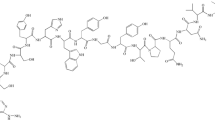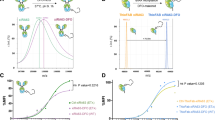Abstract
We have previously reported a method for labeling epidermal growth factor (EGF) with technetium-99m and have shown that 99mTc-EGF localized in EGF receptor (R) positive intracerebral C6EGFR rat gliomas following intratumoral (i.t.) injection of the radioligand. In the present study, we have evaluated the potential use of 99mTc-EGF as a tumor targeting agent after systemic administration to Fischer rats bearing intracerebral implants of C6EGFR gliomas. Radiolocalization was determined following intravenous (i.v.) or intracarotid (i.c.) injection with or without hyperosmotic mannitol induced disruption of the blood–brain barrier (BBB-D). As determined by γ-scintillation counting, 4 h after i.c. injection of 99mTc-EGF, 0.34% of the injected dose per gram (% ID/g) was localized in C6EGFR tumors, which expressed 105–106 EGFR sites per cell, compared to 0.07% ID/g in animals bearing C6 wildtype gliomas, which do not express EGFR. The corresponding tumor to brain ratios were 5.6 and 1.6, respectively. Tumors could be visualized by external γ-scintigraphy in rats bearing C6EGFR but not C6 wildtype gliomas, thereby establishing that radiolocalization was dependent upon receptor expression. Intracarotid administration of 99mTc-EGF significantly increased tumor uptake compared to i.v. injection (0.34 vs 0.14% ID/g, p<0.04). BBB-D disruption, followed by i.c. injection of 99mTc-EGF, however, did not significantly enhance tumor uptake compared to i.c. injection without BBB-D (0.45% vs 0.34% ID/g, p>0.1). The uptake of 99mTc-EGF was ∼4–9% ID/g in the liver and 12–20% ID/g in the kidneys after i.c. or i.v. administration. External γ-scintigraphy of regions of interest over the liver and kidneys revealed that ∼70–80% of the whole body radioactivity accumulated in these organs, and only 0.47–0.83% in the tumor following i.v. or i.c. administration of 99mTc-EGF. Our study has demonstrated that EGF can be used as a specific targeting agent for EGFR (+) rat brain tumors. However, it is unlikely that systemic injection of EGF-based bioconjugates can deliver sufficient amounts of the ligand to brain tumors for therapeutic purposes and direct delivery by means of either intratumoral injection or a variant of it such as convection enhanced delivery will be required.
Similar content being viewed by others
References
Schwechheimer K, Huang S, Cavenee WK: EGFR gene amplification-rearrangement in human glioblastoma. Int J Cancer 62: 145–148, 1995
Bigner SH, Humphrey PA, Wong AJ, Werner MH, Hamilton SR, Muhlbaier LH, Vogelstein B, Bigner DD: Characterization of the epidermal growth factor receptor in human glioma cell lines and xenografts. Cancer Res 50: 8017–8022, 1990
Tuzi NL, Venter DJ, Kumar S, Staddon SL, Lemoine NR, Gullick WJ: Expression of growth factor receptors in human brain tumors. Brit J Cancer 63: 227–233, 1991
Diedrich U, Lucius J, Baron E, Behnke J, Pabst B, Zoll B: Distribution of epidermal growth factor receptor gene amplification in brain tumors and correlation to prognosis. J Neurol 242: 683–688, 1995
Modjtahedi H, Dean C: The receptor forEGF and its ligands: expression, prognostic value and target for therapy in cancer (review). Int J Oncol 4: 227–296, 1994
Mendelsohn J, Baselga J: The EGF receptor family as targets for cancer therapy. Oncogene 19: 6550–6565, 2000
Kalofonos HP, Pawlikowska TR, Hemingway A, Courtenay-Luck N, Dhokia B, Snook D, Sivolapenko GB, Hooker GR, McKenzie CG, Lavender PJ, Thomas DGT, Epenetos AA: Antibody guided diagnosis and therapy of brain gliomas using radiolabeled monoclonal antibodies against epidermal growth factor receptor and placental alkaline phosphatase. J Nucl Med 30: 1636–1645, 1989
Snelling L, Miyamoto CT, Bender H, Brady LW, Steplewski Z, Class R, Emrich J, Rackover MA: Epidermal growth factor receptor 425 monoclonal antibodies radiolabeled with iodine-125 in the adjuvant treatment of highgrade astrocytomas. Hybridoma 14: 111–114, 1995
Faillot T, Magdelenat H, Mady E, Stasiecki P, Fohanno D, Gropp P, Poisson M, Delattre JY: A phase I study of an anti-epidermal growth factor receptor monoclonal antibody for the treatment of malignant gliomas. Neurosurgery 39: 478–483, 1996
Carlsson J, Gedda L, Grönvik C, Hartman T, Lindström A, Lindström P, Lundqvist H, Lövqvist A, Malmqvist J, Olsson P, Essand M, Pontén J, Sjöberg S, Westermark B: Strategy for boron neutron capture therapy against tumor cells with over-expression of the epidermal growth factorreceptor. Int J Radiation Oncol Biol Phys 30: 105–115, 1994
Barth RF, Soloway AH, Fairchild RG: Boron neutron capture therapy of cancer. Cancer Res 50: 1061–1070, 1990
Barth RF, Soloway AH, Goodman JH, Gahbauer RA, Gupta N, Blue TE, Yang W, Tjarks W: Boron neutron capture therapy of brain tumors: an emerging therapeutic modality. Neurosurgery 44: 433–451, 1999
Capala J, Barth RF, Bendayan M, Lauzon M, Adams D, Soloway AH, Carlsson J: Boronated epidermal growth factor as a potential targeting agent for boron neutron capture therapy of brain tumors. Bioconjug Chem 7: 7–15, 1996
Capala J, Barth RF, Bailey MQ, Fenstermaker RA, Marek MJ, Rhodes BA: Radiolabeling of epidermal growth factor with 99mTc and in vivo localization following intracerebral injection into normal and glioma-bearing rats. Bioconjug Chem 8: 289–295, 1997
Fenstermaker RA, Capala J, Barth RF, Hujer A, Kung HJ, Kaetzel DM Jr: The effect of epidermal growth factor receptor (EGFR) expression on in vivo growth of rat C6 glioma cells. Leukemia 9(Suppl 1): S106–S112, 1995
Yang W, Barth RF, Adams DM, Soloway AH: Intratumoral delivery of boronated epidermal growth factor for neutron capture therapy of brain tumors. Cancer Res 57: 4333–4339, 1997
Barth RF, Yang W, Rotaru JH, Moeschberger ML, Joel DD, Nawrocky MM, Goodman JH, Soloway AH: Boron neutron capture therapy of brain tumors: enhanced survival following intracarotid injection of either sodium borocaptate or boronophenylalanine with or without blood-brain barrier disruption. Cancer Res 57: 1129–1136, 1997
Barth RF, Yang W, Rotaru JH, Moeschberger ML, Boesel CP, Soloway AH, Joel DD, Nawrocky MM, Ono K, Goodman JH: Boron neutron capture therapy of brain tumors: enhanced survival and cure following blood-brain barrier disruption and intracarotid injection of sodium borocaptate and boronophenylalanine. Int J Radiation Oncol Biol Phys 47: 209–218, 2000
Barth RF, Yang W, Bartus RT, Moeschberger ML, Goodman JH: Enhanced delivery of boronophenylalanine for neutron capture therapy of brain tumors using the bradykinin analog Cereport (Receptor-Mediated Permeabilizer-7) Neurosurgery 44: 351–360, 1999
Rhodes BA: Direct labeling of proteins with 99mTc. (Review) Nucl Med Biol 18: 667–676, 1991
Yang W, Barth RF, Carpenter MA, Moeschberger ML, Goodman MD: Enhanced delivery of boronophenylalanine by means of intracarotid injection and blood-brain barrier disruption for neutron capture therapy. Neurosurgery 38: 985–992, 1996
Yang W, Barth RF, Bartus RT, Rotaru JH, Moeschberger ML, Nawrocky MM, Coderre JA, Goodman JH: Improved survival after boron neutron capture therapy of brain tumors by Cereport-mediated blood-brain barrier modulation to enhance delivery of boronophenylalanine. Neurosurgery 47: 189–198, 2000
Wikstrand CJ, Cokgor I, Sampson JH, Bigner DD: Monoclonal antibody therapy of human gliomas: current status and future approaches. Cancer Metastasis Rev 18: 451–464, 1999
Zalutsky MR: Growth factor receptors as molecular targets for cancer diagnosis and therapy. Q J Nucl Med 41: 71–77, 1997
Shapiro WR, Green SB, Burger PC, Selker RG, Van Gilder JC, Robertson JT, Mealey Jr J, Ransohoff J, Mahaley MS: A randomized comparison of intra-arterial versus intravenous BCNU, with or without intravenous 5-fluouracil, for newly diagnosed patients with malignant glioma. J Neurosurg 76: 772–781, 1992
Shapiro WR, Voorhies RM, Hiesiger EM, Sher PB, Basler GA, Lipschutz LE: Pharmacokinetics of tumor cell exposure to [14C]methotrexate after intracarotid administration without and with hyperosmotic opeining of the blood-brain and blood-tumor barriers in rat brain tumors: a quantitative autoradiographic study. Cancer Res 48: 694–701, 1988
Dahlborg SA, Petrillo A, Crossen JR, Roman-Goldstein S, Doolittle ND, Fuller KH, Neuwelt EA: The potential for complete and durable response in nonglial primary brain tumors in children and young adults with enhanced chemotherapy delivery. Cancer J Sci Am 4: 110–124, 1998
Madajewicz S, Chowhan N, Tfayli A, Roque C, Meek A, Davis R, Wolf W, Cabahug C, Roche P, Manzione J, Iliya A, Shady M, Hentschel P, Atkins H, Braun A: Therapy for patients with high grade astrocytoma using intraarterial chemotherapy and radiation therapy. Cancer 88: 2350–2356, 2000
Greig NH: Drug delivery to the brain by blood-brain barrier circumvention and drug modification. In: Neuwelt EA (ed) Implication of the Blood-Brain Barrier and its Manipulation. Plenum Press, New York, 1994, pp 311–357
Remsen LG, Trail PA, Hellström I, Hellström KE, Neuwelt EA: Enhanced delivery improves the efficacy of a tumor-specific doxorubicin immunoconjugate in a human brain tumor xenograft model. Neurosurgery 46: 704–709, 2000
Potamianos S, Varavarigou AD, Archimandritis SC: Radioimmunoscintigraphy and radioimmunotherapy in cancer: principles and application. Anticancer Res 20: 925–948, 2000
Schatten C, Pateisky N, Vavra N, Ehrenbock P, Angelberger P, Sivolapenko G, Epenetos A: Lymphoscintigraphy with 123I-labeled epidermal growth factor. Lancet 337: 395–396, 1991
Rusckowski T, Qu T, Chang F, Hnatowich DJ: Technetium-99m labeled epidermal growth factor-tumor imaging of mice. J Peptide Res 50: 393–401, 1997
Reilly RM, Kiarash R, Sandhu J, Lee YW, Cameron RG, Hendler A, Vallis K, Gariépy J: A comparison of EGF and MAb 528 labeled with 111In for imaging human breast cancer. J Nucl Med 41: 903–911, 2000
Ramos-Suzarte M, Rodriguez N, Oliva JP, Iznaga-Escobar N, Perera A, Morales A, Gonzalez N, Cordero M, Torres L, Pimentel G, Borron M, Gonzalez J, Torres O, Rodriguez T, Perez R: 99mTc-labeled antihuman epidermal growth factor receptor antibody in patients with tumors of epithelial origin: Part III. Clinical trials safety and diagnostic efficacy. J Nucl Med 40: 768–775, 1999
Liu S, Edwards S, Barrett JA: 99mTc labeling of highly potent small peptides. Bioconjug Chem 8: 621–636, 1997
Haldemann AR, Rösler H, Barth A, Waser B, Geiger L, Godoy N, Markwalder RV, Seiler RW, Sulzer M, Reubi JC: Somatostatin receptor scintigraphy in central nervous system tumors: role of blood-brain barrier permeability. J Nucl Med 36: 403–410, 1995
Kurihara A, Pardridge WM: Imaging brain tumors by targeting peptide radiopharmaceuticals through the blood-brain barrier. Cancer Res 59: 6159–6163, 1999
Alam F, Barth RF, Soloway AH: Boron containing immuno-conjugates for neutron capture therapy of cancer and for immuno-cytochemistry. Antibody, Immunoconjug Radiopharmaceut 2: 145–163, 1989
Riva P, Franceschi G, Riva N, Casi M, Santimaria M, Adamo M: Role of nuclear medicine in the treatment of malignant gliomas: the locoregional radioimmunotherapy approach. Eur J Nucl Med 27: 601–609, 2000
Chen MY, Lonser RR, Morrison PF, Governale LS, Oldfield EH: Variables affecting convection-enhanced delivery of the striatum: a systematic examination of rate of infusion, cannula size, infusate concentration, and tissue-cannula sealing time. J Neurosurgery 90: 315–320, 1999
Groothuis DR: The blood-brain and blood-tumor barriers: a review of strategies for increasing drug delivery. Neuro-Oncol 2: 45–59, 2000
Jørgensen PE, Seier Poulsen S, Nexø E: Distribution of i.v. administered epidermal growth factor in the rat. Regul Pept 23: 161–169, 1988
Vinter-Jensen L, Frøkiaer J, Jørgensen PE, Marqversen J, Rehling M, Dajani EZ, Nexø E: Tissue distribution of 131I-labeled epidermal growth factor in the pig visualized by dynamic scintigraphy. J Endocrinol 144: 5–12, 1995
Yang W, Barth RF, Adams DM, Ciesielski M, Fenstermaker RA: Boron neutron capture therapy (BNCT) of brain tumors convection enhanced delivery of boronated epidermal growth factor to EGF receptor positive gliomas. Neuro-Oncol 2:304, 2000
Author information
Authors and Affiliations
Rights and permissions
About this article
Cite this article
Yang, W., Barth, R.F., Leveille, R. et al. Evaluation of Systemically Administered Radiolabeled Epidermal growth Factor as a Brain Tumor Targeting Agent. J Neurooncol 55, 19–28 (2001). https://doi.org/10.1023/A:1013017821166
Issue Date:
DOI: https://doi.org/10.1023/A:1013017821166




